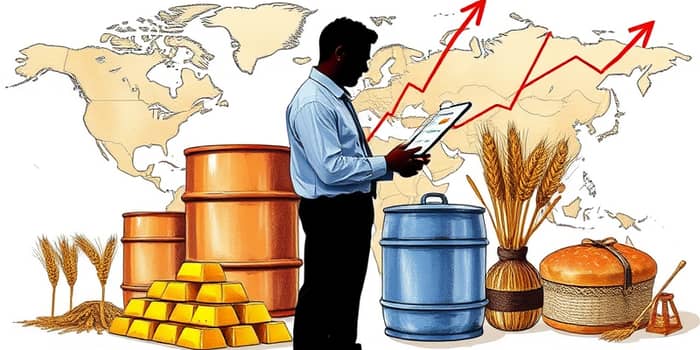Commodity markets have never been more unpredictable, with prices oscillating violently and challenging traditional risk frameworks.
Between 2020 and 2024, we witnessed frequent and sharp price swings that disrupted corporate margins and global economic forecasts, underscoring the critical need for robust hedging strategies.
State of Global Commodity Markets (2024–2025)
Volatility in commodity prices reached its highest level in at least 50 years, driven by a complex interplay of macroeconomic, geopolitical and supply-side factors. After a steep 14% decline in 2023, the aggregate Commodity Price Index contracted by 2% in 2024 and is forecast to fall by another 12% overall in 2025, reaching a six-year low for commodity prices.
Oil markets in particular are under downward pressure. A slowdown in global consumption, expanding supply and the possible unwinding of OPEC+ cuts are expected to keep Brent crude below $70 per barrel through 2025. Meanwhile, more than half of the most liquid commodities are projected to decline by over 10% this year, reflecting broad-based softness.
- Macroeconomic: Weak global growth, prolonged financial tightening, strong US dollar
- Geopolitical: Trade disputes, regional conflicts affecting energy and metals
- Supply-Side: Variable harvests, extreme weather events, energy sector disruptions
- Inflation Environment: Sticky but receding inflation—US CPI at 2.9% (Dec 2024), Core CPI at 3.2%
Impact of Price Volatility
Sharp commodity swings have profound ramifications for both producers and consumers. Corporate margins are under siege: agrichemical companies that leave input costs unhedged have reported annual losses of €15–18 million when raw material prices spike unexpectedly.
At the macro level, large price swings feed through into inflation, interest rate decisions and GDP growth, creating a feedback loop that further fuels volatility. Forecasting becomes a near-impossible task when crises—from pandemics to geopolitical flare-ups—can upend supply and demand within days.
In this environment, the absence of a disciplined risk management program can lead to catastrophic profit erosion and unpredictable cash flows.
Key Hedging Strategies and Tools
Hedging is essential for locking in future prices securely and smoothing out cash flows. It provides operational clarity for procurement and sales scheduling, while safeguarding profit margins.
Strategic Challenges and Opportunities (2025–2026)
Downside risks dominate the near term. A sharper-than-expected slowdown in China or Europe could depress demand for industrial metals and energy, while OPEC+ policy reversals or renewed trade frictions may disrupt supply chains. Conversely, geopolitical shocks or extreme weather—such as droughts in major grain regions—could trigger sudden price spikes, offering opportunities for well-hedged players.
Precious metals stand out as safe havens: gold and silver are both projected to reach new highs in 2025, underlining their role in diversified portfolios.
The Human Factor: Role of Experienced Traders
In an era of heightened volatility in global markets, the expertise of seasoned traders is invaluable. Firms that empower agile risk teams to adjust hedging programs in real time can capture market dislocations, avoid losses and gain a competitive edge. The right talent transforms hedging from a cost center into a strategic asset.
Practical Guidance for Risk Managers and Investors
Successful risk management requires a systematic, flexible approach. One-size-fits-all solutions rarely deliver optimal results.
- Mix and match hedging instruments—use forwards, futures and options based on volume, timing and cost considerations.
- Design strategies that are systematically aligned to actual production or consumption profiles to avoid basis risk.
- Leverage backtesting, scenario analysis and stress testing to refine hedging models before implementation.
- Combine physical contracts with financial hedges for comprehensive cover in both spot and derivative markets.
- Monitor key drivers—US dollar strength, inflation trends and major geopolitical events—to recalibrate positions proactively.
Key Data Points to Remember
• The overall Commodity Price Index: down 2% in 2024, forecast down 12% in 2025 and a further 5% in 2026.
• Brent crude price: projected to remain below $70 per barrel throughout 2025.
• 59% of the most liquid commodities are expected to decline this year, many by over 10%.
• US CPI (Dec 2024): 2.9%, with Core CPI at 3.2%, indicating a still-sticky inflation environment.
• Agrichemical firm case study: systematic hedging could have prevented annual losses of €15–18 million on volatile input costs.
Critical Takeaways and Future Outlook
Price swings will remain the norm as economies grapple with uncertainty, geopolitical divides and climate-related disruptions. Hedging is not merely a financial tactic—it underpins operational survival in commodity-dependent sectors and safeguards profitability.
Looking ahead, success will depend on flexibility, expertise and a multi-instrument approach to risk management. Investors and risk managers must keep a close eye on inflation trajectories, US dollar dynamics and supply-demand shocks to stay ahead of market turns in 2025 and beyond.
References
- https://www.mckinsey.com/industries/electric-power-and-natural-gas/our-insights/managing-industrials-commodity-price-risk
- https://openknowledge.worldbank.org/entities/publication/02d005ef-e3d9-44f5-aada-8ba42663a743
- https://www.stonex.com/en/physical-commodities/risk-management-physical-contracts/
- https://www.morganstanley.com/im/en-gb/intermediary-investor/insights/articles/commodity-outlook-2025-three-areas-to-watch.html
- https://www.fastmarkets.com/insights/commodity-trading-a-guide-to-hedging-futures-contracts-and-zero-cost-collars/
- https://brainworksinc.com/commodities-market-experienced-traders-2025/
- https://www.fnb-online.com/business/knowledge-center/manage-risk/managing-risk-in-commodities-markets-with-hedging-strategies










